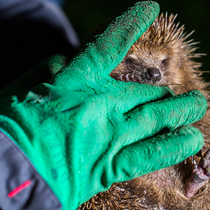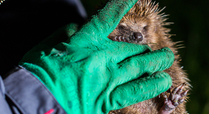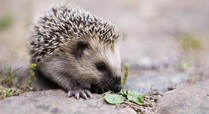Hedgehogs in The Regent's Park
Did you know that hedgehogs still live in The Regent’s Park?
 Hedgehogs are one of the nation’s favourite species, yet there’s been a worrying nationwide decline in hedgehog numbers in the last 25 years and The Regent’s Park is now the only central London Royal Park with a breeding population.
Hedgehogs are one of the nation’s favourite species, yet there’s been a worrying nationwide decline in hedgehog numbers in the last 25 years and The Regent’s Park is now the only central London Royal Park with a breeding population.
With the help of top wildlife scientists and over 100 volunteers, we discovered a small population of around 40-50 animals living and breeding in the Park in 2014. Our hedgehog team returned to The Regent’s Park in May and September 2015 to see how the vulnerable population had fared over the winter and find out more about their nocturnal activities.
Our research
We're working with The Royal Parks, The Zoological Society of London (ZSL), People's Trust for Endangered Species, the Central Royal Parks Wildlife Group, two eminent wildlife scientists and lots of amazing volunteers to survey the hedgehogs in Regent’s Park. We're aiming to find out all about this elusive nocturnal animal and help safeguard this precious population. Find our more about the scientific study and our research methods here.
Technology played a huge part in 2015’s study, with thermal imaging cameras being used, a rarity in these types of projects, along with radio tagging and GPS tracking. A DNA analysis of the hedgehogs’ spines is also planned for the summer to find out more about the genetic make-up of this small population.
What did we find in the Park?
- In 2014 we found a small hedgehog population estimated to be around 40-50 individuals. Young animals were found in both September 2014 and 2015 confirming that the population had bred.
- Fewer hedgehogs were found in September 2015, highlighting that this is a small and very vulnerable which is possibly declining. Monitoring will need to continue for a number of years to confirm a trend.
- The hedgehogs preferred to forage in short grassland within a mosaic of shrubberies and hedges. They avoided large areas of very short grass such as the sports pitches.
- They preferred to nest in areas of dense undergrowth such as brambles, ivy or hedges with dense vegetation at their base where they could use fallen leaves and grass to build their expertly constructed nests.
- The hedgehogs travelled up to 1.5 km, nearly one mile, per night – the equivalent of three stops on the Underground between Regent’s Park and The Angel, Islington!
- Our adult hedgehogs had an average body weight of 960g, above the national average. Which means there's evidently plenty of food to eat in the Park!
- Analysis of the responses to the 2015 residents questionnaire supported the hypothesis that this is an isolated and vulnerable population:
- No confirmed recent hedgehogs sightings within 1km of Regent’s Park
- 7 people provided historical sightings of hedgehogs in their gardens near to the Park
- No recent sightings of hedgehogs on Primrose Hill
- 40 people confirmed hedgehog sightings in Regent’s Park in 2015 and in previous years
- 98 animals reported (including 50 by Park Manager!)
Hedgehog friendly habitats
- We've drawn up some habitat management recommendations so that the Regent's Park team can continue to maintain the Park in a ‘hedgehog-friendly’ way. These plans include letting the grassland adjacent to the hedges grow longer to provide a richer environment for hedgehog foraging and nesting.
Raising awareness of hedgehog conservation
- Three hedgehog conservation training sessions have been delivered for Regent’s Park grounds staff and their managers.
- Our expert wildlife scientists have shared the results of the survey and recommendations at a range of conferences helping others to understand more about hedgehog conservation.
- Our research will be useful guidance for other green space managers who want to understand and adopt hedgehog conservation techniques.
- During the school holidays we offered hedgehog themed family Discovery Days where over 330 children and 200 adults visited us to find out more about the secret lives of hedgehogs..
- We supplied the cafes in Regent’s Park with hedgehog activity sheets, allowing children to learn about hedgehog ecology in an informal and fun way.
What's next?
- We’ll continue to monitor this vulnerable population year on year to try and detect trends in the population and continue to find ways to help safeguard their future.
- We’re trialling the use of nest boxes in Regent’s Park to provide additional secure nesting sites which may provide some protection against inquisitive dogs and foxes.
- The Regent’s Park team will continue to implement the habitat management recommendations made to maintain the Park in a ‘hedgehog-friendly’ way. There will be a focus on improving connectivity throughout the Park particularly in respect to road casualties.
- We’ll continue with our awareness raising campaign, particularly focusing on inspiring children and their families about hedgehog conservation at Discovery Days at our Education Centre in Hyde Park.
How you can support the hedgehogs
 The Regent’s Park hedgehog population that we're studying is an isolated and extremely vulnerable one, which needs protecting. There are lots of ways you can help support the hedgehogs in Regent’s Park - find out all about them here.
The Regent’s Park hedgehog population that we're studying is an isolated and extremely vulnerable one, which needs protecting. There are lots of ways you can help support the hedgehogs in Regent’s Park - find out all about them here.
You can keep up-to-date with this project and all of our work by following us on Facebook and Twitter.
To find out more about how you can help hedgehogs in your garden visit Hedgehog Street.

